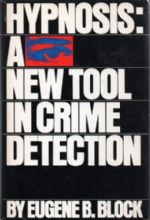HYPNOSIS: A New Tool in Crime Detection
Author: Block (Eugene B.)
Year: 1976
Publisher: David Mckay & Co. (New York)
Edition Details: 1st US Edn.
Book Condition: F/Vg+
ISBN: 0679506047
Price: £8.00
IN STOCK NOW
Hardback. Featuring a collection of case histories dealing with the science of hypnotism. Hypnotism has long been practiced without being fully understood - in the Svengali tradition it is many times visualised as a means of manipulating the subject's will, possibly for the perpetration of crimes. But its place in criminology is based on much more. Witnesses are hypnotised to provide repressed details from the scene of a crime or an accurate description of criminals. Suspects in hypnotic trance offer forgotten alibis or sometimes motives and confessions: a young lady in San Francisco was hypnotised to help her understand the reason behind her bizarre sexual behaviour; only by hypnosis could a young father remember if he had, in fact, fatally injured his baby, and in several heart warming cases hypnosis cleared wrongfully convicted and imprisoned citizens. The author guides us through the intriguing history of hypnosis, including its battle for legal acceptance and the significant contributions the practice has made to the fields of justice and law enforcement. Hypnosis played a major part in some of the best-known crimes of the 20th century - the kidnapping of Jimmy Hoffa, the assassination of Robert Kennedy - and was effectively used by F. Lee Bailey in the Sam Sheppard murder case and the trial of the Boston Strangler. With Index. 240pp. 8vo. h/back. From the library of true crime writer, Wilfred Gregg, with his personal b/plate. F. in Vg+ dw.
Titles Recently Added To The Catalogue
Wants list
If you're after a particular title, enter your details below
Selling a Book?
Enter the details below and we'll be in touch shortly


